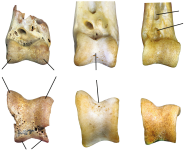Fred Ruhe
Well-known member

Nikita V. Zelenkov, 2023
A New Species of Sandgrouse (Aves: Pteroclidae) from the Early Pleistocene of the Crimea
Doklady Biological Sciences 511, 264–266 (2023).
Abstract: A New Species of Sandgrouse (Aves: Pteroclidae) from the Early Pleistocene of the Crimea - Doklady Biological Sciences
Sandgrouse (Pteroclidae, Pterocliformes) are specialized ground birds of open arid landscapes with a very poorly studied evolutionary history. In the late Pliocene–early Pleistocene, Pteroclidae are known only from few localities in Southern Europe. The article describes a relatively large fossil sandgrouse from the early Pleistocene of the Taurida cave in the Crimea. This is the first record of Pteroclidae in the ancient faunas of the Black Sea region and Eastern Europe. The unusual structure of the tibiotarsus makes it possible to describe the fossil form from Taurida Cave as a new species, Pterocles bosporanus sp. nov.
Enjoy,
Fred
A New Species of Sandgrouse (Aves: Pteroclidae) from the Early Pleistocene of the Crimea
Doklady Biological Sciences 511, 264–266 (2023).
Abstract: A New Species of Sandgrouse (Aves: Pteroclidae) from the Early Pleistocene of the Crimea - Doklady Biological Sciences
Sandgrouse (Pteroclidae, Pterocliformes) are specialized ground birds of open arid landscapes with a very poorly studied evolutionary history. In the late Pliocene–early Pleistocene, Pteroclidae are known only from few localities in Southern Europe. The article describes a relatively large fossil sandgrouse from the early Pleistocene of the Taurida cave in the Crimea. This is the first record of Pteroclidae in the ancient faunas of the Black Sea region and Eastern Europe. The unusual structure of the tibiotarsus makes it possible to describe the fossil form from Taurida Cave as a new species, Pterocles bosporanus sp. nov.
Enjoy,
Fred




